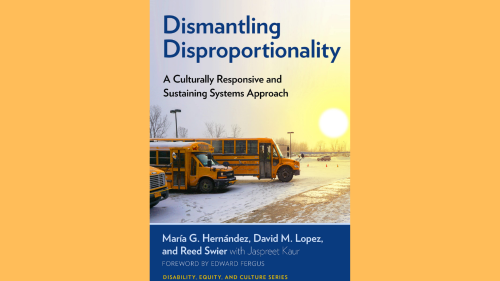Disproportionality “...is in many ways a microcosm of the existing sociopolitical and racial inequities in our society. It starts in the classrooms and cumulatively leads to visibly disproportionate patterns in schools, districts, states, and the nation as a whole. Numerous districts across the nation—including New York City Schools—have been cited year after year for disproportionate outcomes. There are various factors which cause disproportionality that are not only tied to the way the system is structured but also to the existing policies, practices, and mindsets of the individuals engaged in student placement and discipline at various levels. Black and Brown children, the children who are most often perceived as different culturally and linguistically, are at risk in our schools.” (Kaur, J. Understanding Disproportionality Part 1: What Disproportionality Is and Why It Matters, 2019 )
Dismantling Disproportionality: A Culturally Responsive and Sustaining Systems Approach is a new book which positions disproportionality not solely as a special education issue, but rather, a broader issue of educational inequality. Disproportionality in special education parallels a still larger, and even more persistent history of chronic socioeconomic and racial inequalities relating to the country's history of denying educational opportunities to students of color, multilingual students, students with disabilities, and those at the intersections of these identities.
The authors of Dismantling Disproportionality understand that disproportionality is not simply an outcome. Instead, disproportionality is about the overall experiences our children are having in educational settings–experiences that ultimately lead to these disparities. This book draws on the authors’ experiences as technical assistance providers with the Center for Disproportionality, coupled with the latest research findings on the causes of racial disproportionality in general and special education. Dismantling Disproportionality’s four case study chapters underscore the diverse pathways in which school districts were engaged. It is this inspirational, equity-centered approach the authors have taken, that has propelled Dismantling Disproportionality to be well received by education equity advocates and book reviewers alike.
A recent review in the Teachers College Record applauds the text for both its courage and “unflinching” character in confronting the arduous topic of disproportionality. Disproportionality is a complex and persistent problem plaguing classrooms throughout the United States; the review embraces Dismantling Disproportionality’s inventiveness as it pertains to the text’s approach to disproportionality, “...the problem must be rooted in both adaptive and technical solutions–solutions that not only transform school systems, but also the beliefs of the educators running those systems”. This scholarly assessment also praises the authors of Dismantling Disproportionality for “... the clear and concise messaging used in “... outlining the difficulty involved in doing the work of disrupting educational inequity in schools.” The most endearing recommendation of the book is made during the review's affirmation of the author’s aggregated wisdom garnered from years delivering technical assistance to school districts. The Teachers College Record review asserts “Dismantling Disproportionality: A Culturally Responsive and Sustaining Systems Approach offers a guide for untangling these complexities by telling the stories of lessons learned over decades of disproportionality research and technical assistance to school districts across the country.
Recommendations and cheer for Dismantling Disproportionality stretch from the East Coast to the West, with the former Peter L. Agnew Professor of Education at NYU, and now Dean of the USC Rossier School of Education, Dr. Pedro Noguera speaking to the consequence and priority of the text. Noguera exclaims that this important “new book is hopeful and inspiring. It shows us that by reflecting on our actions and holding ourselves accountable, educators can take action to make schools more just and equitable.”
Equity stalwarts and literary critics have not been the only audiences to compliment Dismantling Disproportionality. School administrators and district leaders have commended the authors’ embrace of culturally responsive education frameworks, as well as the implementation of equity-focused practices. Uniondale, NY Principal Dr. Bilal Polson lauds Dismantling Disproportionality as “...a truthful authentic and practical text with a focus in application and use for school leaders, families and students.” The longtime education professional agrees with a key tenet of the book, that race and disproportionality cannot be separated. Dr. Polson continues his appreciation for the book and its focus on what is most important. The Nassau County High School Principal notes an appreciation for Dismantling Disproportionality’s ability to capture “... ways to support, center and strengthen the students and families who are the most vulnerable and who have the most at stake and much to contribute.”

Dismantling Disproportionality: A Culturally Responsive and Sustaining Approach
This new book is written by a quartet of NYU Metro Center staffers and alum, including Dr. María G. Hernández, David M. Lopez, and Reed Swier, with Jaspreet Kaur. Their new book is currently available in paperback, hardcover, and ebook.

